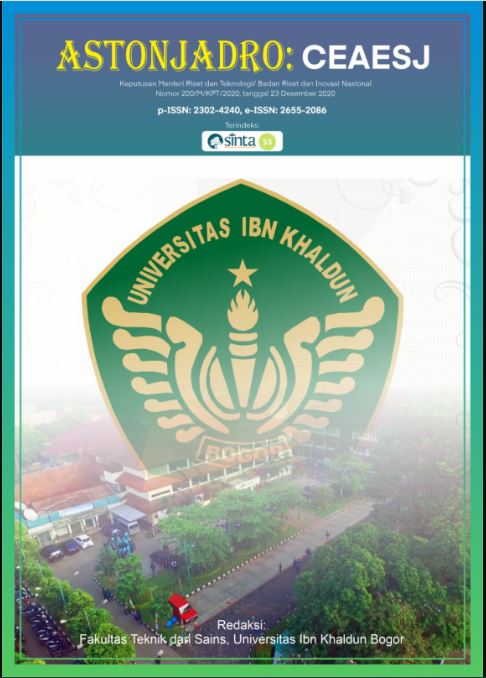EFFECT OF TOURISM POTENTIAL ON THE DEVELOPMENT OF PAKSEBALI TOURISM VILLAGE, KLUNGKUNG BALI REGENCY
DOI:
https://doi.org/10.32832/astonjadro.v11i2.6157Keywords:
tourism potential, master plan, sustainable concept, investors, hospitality aspect.Abstract
The identity of the village as a tourism village is not only formal, but more than that, it must be able to be accounted for in its operational context. This operational context requires support from all parties so that the sustainability of the tourist village can be maintained. The thing that needs to be considered in the development of a tourist village is the sustainability of its potential. Because the purpose of a tourist village is to provide an opportunity for the community providing tourism to take part in their assets, not just being a spectator to tourism activities whose profits are enjoyed by investors (not local people). Therefore, it is necessary to identify the tourism potential that exists in Paksebali village before making arrangements that pay attention to the hospitality aspect and also the sustainability of natural, cultural and other potentials for the welfare of the local community. The problem that arises in the Paksebali Tourism Village is that the tourist attractions are far apart so that efficient circulation is very important in planning the master plan on a macro basis. And on a micro scale, the need for tourism support facilities that are hospitality and are responsible for the tourism potential available as a sustainable concept.
References
Antara, Made. (2016). Panduan Tata Kelola Desa Wisata Kenderan.
(edisi 1). Gianyar. Bappeda Kabupaten Gianyar. Diakses dari www.academia.edu
Arif, A.W. (2014). Teori Interior (I). Jakarta. Griya Kreasi.
A, Yoeti. Oka. (1996). Pengantar Ilmu Pariwisata. Bandung. Angkasa. Diakses dari https://digilib.esaunggul.ac.id
Ching, F. D. (2008). Arsitektur, Bentuk, Ruang, dan Tatanan. Jakarta: Erlangga.
Diksa, I. W. (2007). Buku Ajar Struktur III. Denpasar: Tidak Diterbitkan.
Dirjen Pariwisata RI. Pelaksanaan Usaha dan Penggolongan Restoran. (No: 15/U/11/1988 Tanggal 25 Februari 1988). Jakarta. Penulis. Diakses dari https://peraturan.bkpm.go.id
Frick, Heinz. (2003). Ilmu Konstruksi Bangunan Kayu. Yogyakarta. KANISIUS. Diakses dari https://library.um.ac.id
Kementrian Pariwisata RI. (2018). Peraturan Kemenpar tentang Petunjuk Operasional Pengelolaan Dana Alokasi Khusus Fisik Bidang Pariwisata. (Nomor 3 tahun 2018). Jakarta. Penulis. Diakses dari www.djpk.kemenkeu.go.id
Lynch, Kevin. (1960). Image of the City. Diakses dari www.miguelangelmartinez.net
Marlina, Endy. (2007). Panduan Perancangan Bangunan Komersil. Yogyakarta. ANDI. Diakses dari https://library.polsri.ac.id
Ministry of Culture, Sports and Tourism Vietnam. (2013). Vietnam Tourist Centre Guide. Vietnam. Diakses dari https://vietnamtourism.gov.vn
Mustika, N. M. (2012). Buku Ajar Utilitas 1. Denpasar: Tidak Diterbitkan.
Pemerintah Desa Wisata Paksebali. (2017). Profil Desa Wisata Paksebali. Klungkung. Diakses dari https://paksebali.desa.id
Pemerintah Kabupaten Klungkung. (2017). Peraturan Bupati Klungkung tentang Rencana Kerja Pemerintah Daerah (Nomor 14 tahun 2017). Klungkung. Penulis. Diakses dari http://klungkungkab.go.id
Ratodi, M. (2015). Pendekatan Perencanaan Perkotaan Dalam Konteks Kesehatan Perkotaan. 2. 37. Diakses dari http://emara.uinsby.ac.id/
Shirvani, Hamid. (1985). Elemen Pembentuk Ruang Kota. Diakses dari https://eprints.undip.ad.id
Suwena, I. Ketut. (1910). Pengetahuan Dasar Ilmu Pariwisata. Denpasar. Pustaka Larasan. Diakses dari https://simdos.unud.ac.id/
U.S. Departement of the Interior. (2007). Visitor Center Policy, Directive and Standard, and Guidelines. Diakses dari https://www.usbr.gov
Undang – Undang Republik Indonesia No.10 tahun 2009 tentang Kepariwisataan
Undang – Undang Republik Indonesia No.9 tahun 1990 tentang Kepariwisataan
Downloads
Published
How to Cite
Issue
Section
License
Paper submitted to ASTONJADRO is the sole property of the Astonjadro Journal. Unless the author withdraws the paper because he does not want to be published in this journal. The publication rights are in the journal Astonjadro.ASTONJADRO
LICENSE
This work is licensed under a Creative Commons Attribution-ShareAlike 4.0 International License.
Based on a work at http://ejournal.uika-bogor.ac.id/index.php/ASTONJADRO













